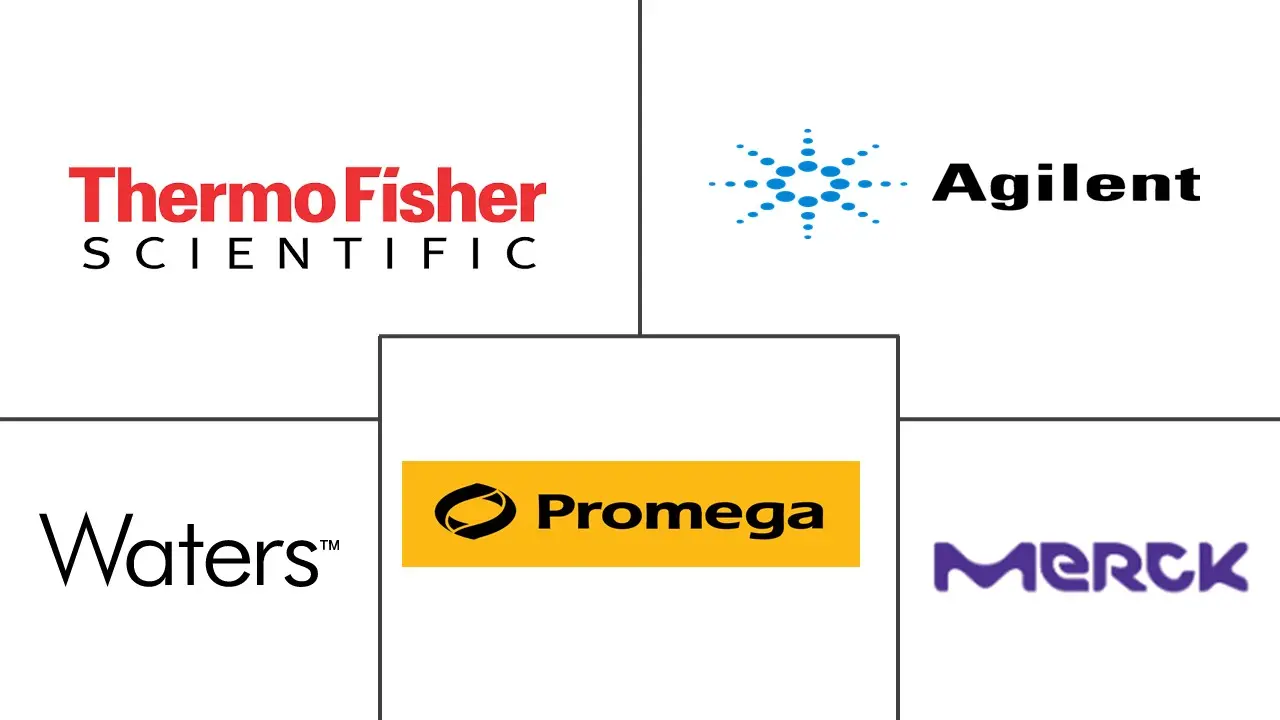Protein Characterization And Quantification Market Size and Share
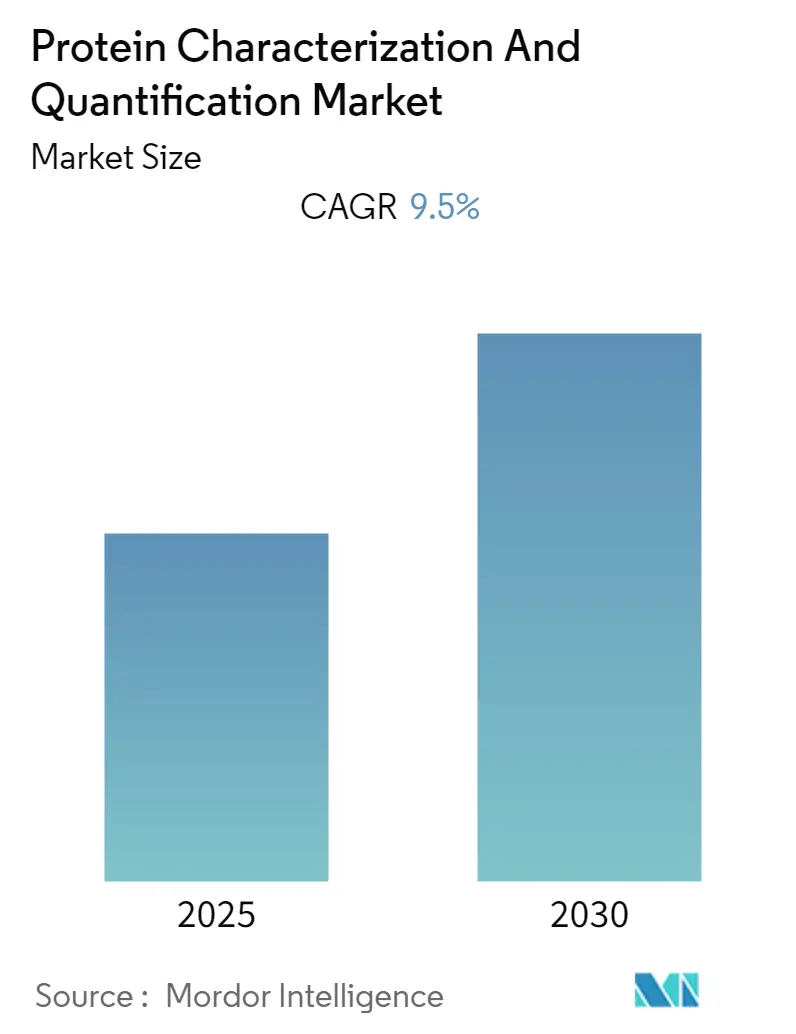
Protein Characterization And Quantification Market Analysis by Mordor Intelligence
The Protein Characterization And Quantification Market is expected to register a CAGR of 9.5% during the forecast period.
Factors such as increasing adoption of biologics, increasing R&D expenditure, and government funding for proteomics and technological advancements in protein characterization and quantification are expected to boost the market's growth during the forecast period.
The growing adoption of biologics is due to the increasing prevalence of chronic diseases and technological advancements in research and development. For instance, a report by the Convention on Pharmaceutical Ingredients (CPHI) in October 2023 highlighted a significant growth in the demand for biologics, owing to its potential to treat diseases previously considered untreatable or difficult to manage, across the world. Thus, the increasing adoption of biologics for treating various chronic diseases propels the growth of protein characterization and identification systems as it plays a crucial role in ensuring the quality, safety, and efficacy of biological drugs.
Similarly, according to a report published by Scorpius Biomanufacturing in May 2023, the demand for biologic drugs rose at 12–14% annually due to an expanding range of modalities like proteins, antibodies, cell therapies, and vaccines. Thus, the increasing adoption of biologics for treating various chronic diseases propels the growth of protein characterization and identification systems as it plays a crucial role in ensuring the quality, safety, and efficacy of biological drugs. Thus, with the expansion of the biologics segment, the need for accurate analysis of protein structures, post-translational modifications, and impurities drives the need for advanced characterization technologies, thereby propelling the market's growth.
Furthermore, governments and private bodies promote research in proteomics and protein studies by raising funds. As a result, the protein detection and quantification market is expected to grow significantly in the coming years. For instance, in January 2023, Novo Holdings invested more than USD 40 million into Evosep, a proteomics technology company leading the standardization of proteomics for clinical applications. This substantial investment is designated to propel the clinical applications of proteomics, leveraging Evosep's cutting-edge liquid chromatography platform. With this investment, Evosep is poised to bolster its global footprint and make significant inroads into the burgeoning US market, offering a robust, high-throughput proteomics solution to a wider clientele.
Moreover, in June 2023, a study in cells highlighted the potential of high-throughput proteomics (HTP) in functional proteomics through a collaboration involving Kustatscher, Ralser, and Christoph Messner. Kustatscher and team leveraged HTP-MS proteomics, employing data-independent acquisition (DIA), to conduct the most extensive proteomic analysis. The research delved into the proteomes of 4,699 strains of Saccharomyces cerevisiae, each with a distinct gene deletion. The study enabled researchers to understand how the proteome responds to genetic changes, offering functional insights into numerous lesser-known yeast genes. Consequently, these findings provide crucial biological understandings that were previously impossible at this scale.
Therefore, owing to the high adoption of biologics, rising research investments, and the utilization of novel technologies in proteomics studies, the studied market is anticipated to grow over the analysis period. However, the high cost associated with instrumentation is anticipated to impede the growth of the protein characterization and quantification market during the forecast period.
Global Protein Characterization And Quantification Market Trends and Insights
The Mass Spectrometry Instruments Segment is Expected to Witness Significant Growth During the Forecast Period
A mass spectrometer is an instrument that generates ions and then sorts them based on their mass-to-charge (m/z) ratio. Its key components comprise an ion source, a mass analyzer, a detector, and a vacuum system.
Mass spectrometry plays a pivotal role in both characterizing and quantifying proteins. It precisely measures protein and peptide masses, identifies post-translational alterations, examines protein assemblies, and gauges protein levels in intricate mixtures. Mass spectrometry unveils intricate details about protein structures and concentrations by ionizing proteins and segregating ions by their mass-to-charge ratio.
Various research studies were conducted to understand the application of tandem mass spectrometry in protein analysis for biomedical research. For instance, according to an article published by Molecules in April 2022, tandem mass spectrometry methods have proven effective in clinical protein characterization and identification research. They are utilized for qualitative and quantitative bioanalysis of proteins and peptides, including their post-translational modifications (PTMs) and protein-protein interactions (PPIs), across a spectrum of biological samples.
Additionally, advancements in mass spectrometry techniques are facilitating a shift from targeted to untargeted proteomic approaches. This transition is driving the emergence of new omics fields, notably PTM-omics and PPI-omics. These developments are pivotal in enhancing the comprehension of normal and pathological cell states and disease mechanisms. Thus, the rising application and advancements in mass spectrometry techniques and instruments are expected to fuel the adoption of mass spectrometry in studying protein characterization and quantification. This, in turn, is anticipated to augment the segment growth during the forecast period.
Further, a study published in PLOS Biology in April 2022 emphasized the pivotal role of mass spectrometry in quantitatively studying cardiac proteins. It highlighted how mass spectrometry allows for a detailed assessment of protein levels in different cardiac chambers, facilitating comparisons between human and model organism's cardiac protein profiles. This research underscores the significant potential of mass spectrometry in quantifying proteins, particularly in its applications to disease research, hence anticipated to bolster the segment's growth during the forecast period.
Moreover, the rising number of product launches by the key players is expected to fuel the availability of advanced mass spectrometry systems in the market, propelling the segment's growth. For instance, in June 2023, Bruker Corporation launched a new timsTOF Ultra mass spectrometer that can identify over 55K peptides that map into 5000 protein groups at the single-cell level of 0.125 ng protein loading, at 1% FDR and over 4800 protein groups quantified at CVs of <20%.
Therefore, owing to the rising number of research studies on using mass spectrometry in proteomics, advancements in mass spectrometry techniques, and new product launches, the studied segment is expected to grow during the forecast period.
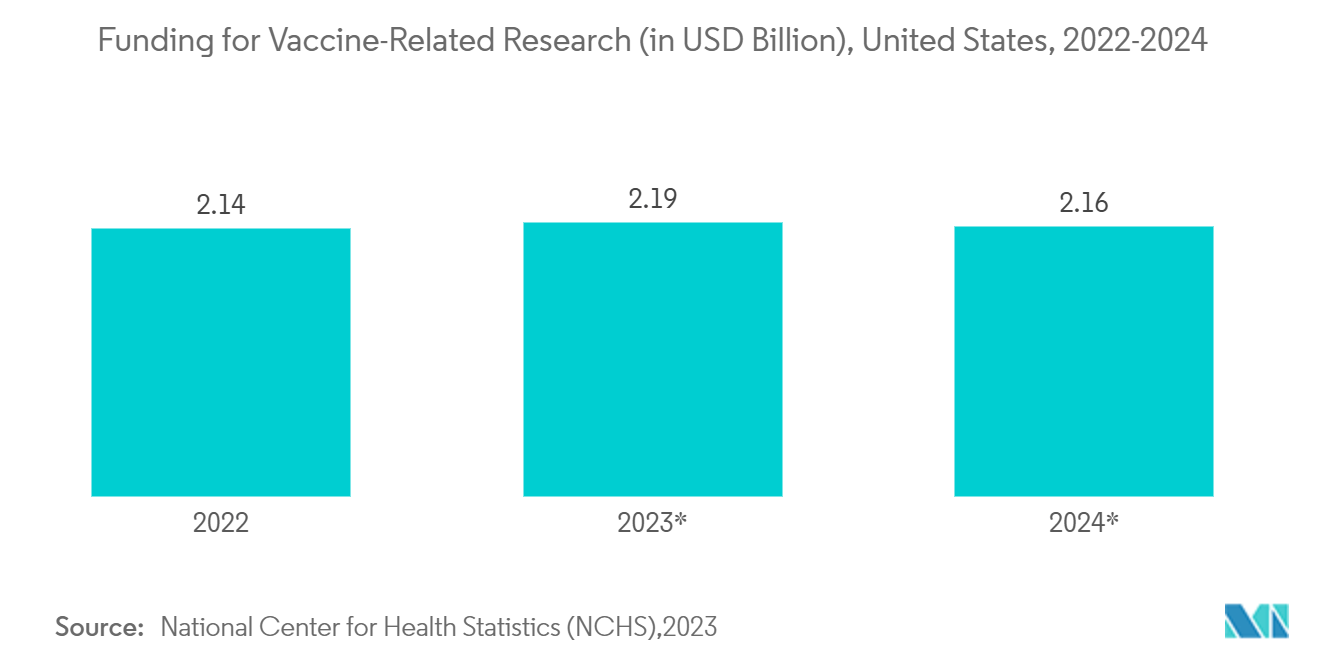
North America is Expected to Witness Significant Growth During the Forecast Period
North America is expected to witness significant growth during the forecast period, owing to the high prevalence of chronic diseases, increasing demand for biologics, government funding for proteomics, and technological advancements in protein characterization and quantification systems. In addition, the presence of key players and their growing strategic activities are expected to boost the market's growth during the forecast period.
The increasing prevalence of cancer among the population raises the demand for effective biologics, which require accurate diagnosis and research of the proteins involved in the disease for developing personalized medicines. This propels the demand for systems that help accurately identify and quantify proteins, propelling the growth of the studied market. For instance, according to the 2024 data published by the American Cancer Society, over 2.1 million people in the United States are expected to be diagnosed with cancer in 2024, compared to 1.9 million people in 2023. Thus, the expected increase in cancer cases is anticipated to boost the demand for detecting and isolating a protein, thereby contributing to the market's growth.
Moreover, data released by the Canadian Cancer Society in November 2022 revealed that Canada experienced over 233,900 new cancer diagnoses in 2022. This surge in cancer cases fuels an increasing demand for gene and monoclonal antibody therapies that are particularly used in the treatment of cancer, rare diseases, and other disorders. Hence, this is expected to drive the market's growth during the forecast period.
Additionally, the market players' key developments are expected to drive the region's growth. For instance, in January 2024, Alamar Biosciences launched the ARGO HT System, which is designed for effortless, high-sensitivity protein analysis in biofluids. The ARGO HT System streamlines NULISA assays, requiring under 30 minutes of hands-on time, significantly reducing the variability inherent in manual assays. This enhances efficiency and liberates researchers' time. The company aims to provide advanced protein analysis through this launch, enhancing sensitivity and multiplexing capabilities. This is expected to aid in identifying crucial biomarkers pivotal in disease advancement and treatment efficacy.
Similarly, in January 2023, Bio-Techne Corporation introduced the ProteinSimple-branded MauriceFlex, a novel system that not only facilitates protein charge variant fractionation but also conducts routine cIEF and CE-SDS assays. This unique offering significantly enhances protein characterization workflows. With the MauriceFlex, users can now perform cIEF-based fractionation on the same day, eliminating the traditional requirements of method development, separate fractionation steps, and the need for data alignment with ion-exchange chromatography (IEX) or alternative methods.
Therefore, owing to the factors above, such as the high burden of cancer and new product launches by the key players, the studied market is anticipated to grow in North America during the forecast period.
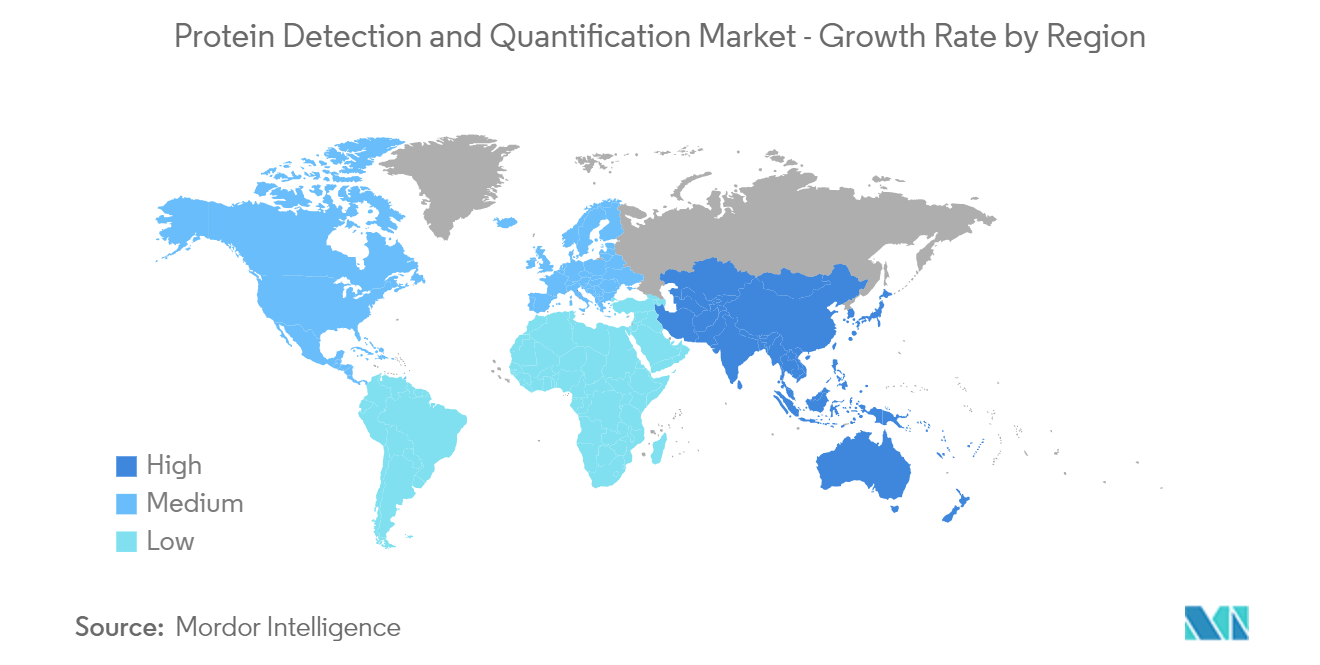
Competitive Landscape
The protein characterization and quantification market is semi-consolidated due to a few companies operating globally and regionally. Some of the key players are focusing on adopting various key strategic activities, such as partnerships and new product launches, to retain their position in the market. Some of the key players in the market are Thermo Fisher Scientific Inc., Agilent Technologies, Promega Corporation, Waters, and Merck KGaA.
Protein Characterization And Quantification Industry Leaders
-
Thermo Fisher Scientific Inc.
-
Agilent Technologies
-
Promega Corporation
-
Waters
-
Merck KGaA
- *Disclaimer: Major Players sorted in no particular order
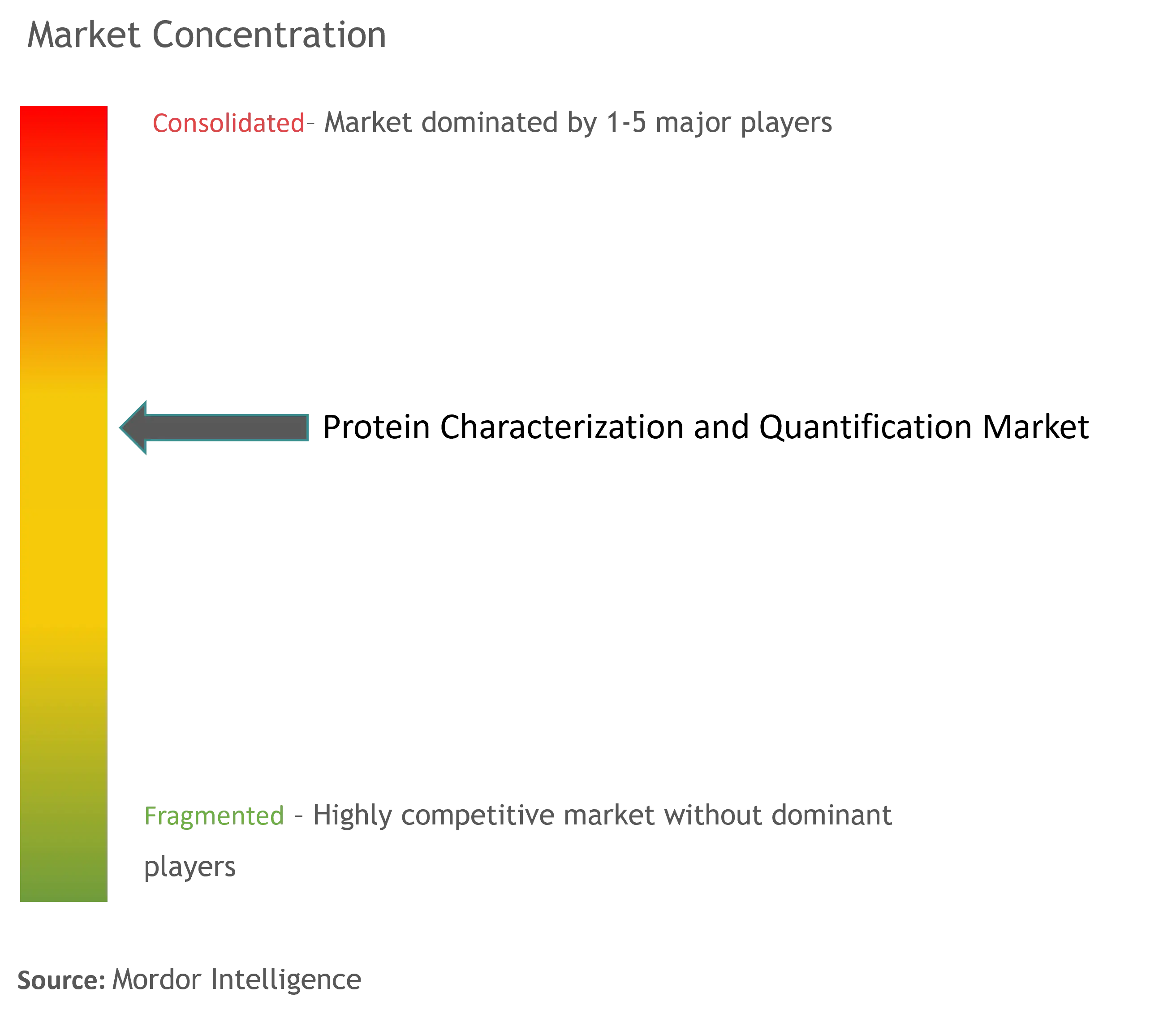
Recent Industry Developments
- June 2024: CMP Scientific launched its highly anticipated BioSummit CVA system, which revolutionizes online charge variant analysis of recombinant protein therapeutics, offering unparalleled precision and robustness for capillary zone electrophoresis-mass spectrometry (CZE-MS) and capillary isoelectric focusing-mass spectrometry (cIEF-MS) applications, at the 72nd ASMS Conference on Mass Spectrometry and Allied Topics.
- January 2024: Agilent Technologies Inc. launched a new automated parallel capillary electrophoresis system for protein analysis, the Agilent ProteoAnalyzer System, at the Annual PepTalk Conference in the United States. This new platform streamlines and enhances the analysis of intricate protein mixtures, a pivotal step in the analytical workflows of the pharmaceutical, biotechnology, and academic sectors.
Global Protein Characterization And Quantification Market Report Scope
As per the scope of the report, protein characterization involves using experimental methods that allow for the detection and isolation of a protein and its purification, as well as the characterization of its structure and function. On the other hand, protein quantification is required to determine the total protein content of a sample or a formulated product.
The protein characterization and quantification market is segmented by product and services, application, end user, and geography. By product and services, the market is segmented into consumables, instruments (mass spectrometry instruments, chromatography instruments, electrophoresis instruments, label-free detection instruments, spectroscopy instruments, and other instruments), and services. By application, the market is segmented into drug discovery and development, clinical diagnosis, and other applications. By end user, the market is segmented into pharmaceutical and biotechnology companies, contract research organizations, and other end users. By geography, the market is segmented into North America, Europe, Asia-Pacific, Middle East and Africa, and South America. The report offers the value (USD) for the above segments.
| Consumables | |
| Instruments | Mass Spectrometry Instruments |
| Chromatography Instruments | |
| Electrophoresis Instruments | |
| Label-free Detection Instruments | |
| Spectroscopy Instruments | |
| Other Instruments | |
| Services |
| Drug Discovery and Development |
| Clinical Diagnosis |
| Other Applications |
| Biotechnology and Pharmaceutical Companies |
| Contract Research Organization |
| Other End Users |
| North America | United States |
| Canada | |
| Mexico | |
| Europe | Germany |
| United Kingdom | |
| France | |
| Italy | |
| Spain | |
| Rest of Europe | |
| Asia-Pacific | China |
| Japan | |
| India | |
| Australia | |
| South Korea | |
| Rest of Asia-Pacific | |
| Middle East and Africa | GCC |
| South Africa | |
| Rest of Middle East and Africa | |
| South America | Brazil |
| Argentina | |
| Rest of South America |
| Product and Services | Consumables | |
| Instruments | Mass Spectrometry Instruments | |
| Chromatography Instruments | ||
| Electrophoresis Instruments | ||
| Label-free Detection Instruments | ||
| Spectroscopy Instruments | ||
| Other Instruments | ||
| Services | ||
| Application | Drug Discovery and Development | |
| Clinical Diagnosis | ||
| Other Applications | ||
| End User | Biotechnology and Pharmaceutical Companies | |
| Contract Research Organization | ||
| Other End Users | ||
| Geography | North America | United States |
| Canada | ||
| Mexico | ||
| Europe | Germany | |
| United Kingdom | ||
| France | ||
| Italy | ||
| Spain | ||
| Rest of Europe | ||
| Asia-Pacific | China | |
| Japan | ||
| India | ||
| Australia | ||
| South Korea | ||
| Rest of Asia-Pacific | ||
| Middle East and Africa | GCC | |
| South Africa | ||
| Rest of Middle East and Africa | ||
| South America | Brazil | |
| Argentina | ||
| Rest of South America | ||
Key Questions Answered in the Report
What is the current Protein Characterization And Quantification Market size?
The Protein Characterization And Quantification Market is projected to register a CAGR of 9.5% during the forecast period (2025-2030)
Who are the key players in Protein Characterization And Quantification Market?
Thermo Fisher Scientific Inc., Agilent Technologies, Promega Corporation, Waters and Merck KGaA are the major companies operating in the Protein Characterization And Quantification Market.
Which is the fastest growing region in Protein Characterization And Quantification Market?
North America is estimated to grow at the highest CAGR over the forecast period (2025-2030).
Which region has the biggest share in Protein Characterization And Quantification Market?
In 2025, the Asia-Pacific accounts for the largest market share in Protein Characterization And Quantification Market.
What years does this Protein Characterization And Quantification Market cover?
The report covers the Protein Characterization And Quantification Market historical market size for years: 2019, 2020, 2021, 2022, 2023 and 2024. The report also forecasts the Protein Characterization And Quantification Market size for years: 2025, 2026, 2027, 2028, 2029 and 2030.
Page last updated on:
Protein Characterization And Quantification Market Report
Statistics for the 2025 Protein Characterization And Quantification market share, size and revenue growth rate, created by Mordor Intelligence™ Industry Reports. Protein Characterization And Quantification analysis includes a market forecast outlook for 2025 to 2030 and historical overview. Get a sample of this industry analysis as a free report PDF download.
